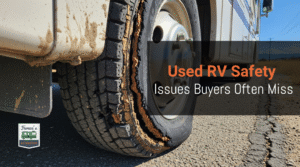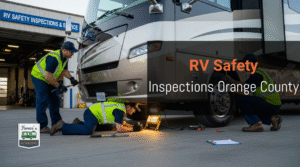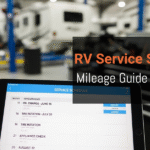Choosing the right bike rack for your RV can make your travels more enjoyable and stress-free. A high-quality bike rack not only secures your bicycles but also ensures they are easy to access while you’re on the go. With numerous options available, you may feel overwhelmed when trying to find the best fit for your specific needs.
At Farace Automotive & RV Center, we understand the importance of safely transporting your bikes alongside your RV. With over 40 years of experience in the RV industry, we offer insights to help you navigate the features and benefits of different bike racks. Whether you’re planning a weekend getaway or a long road trip, we want to help you make an informed decision that enhances your adventure.
As you read this article, you will discover key factors to consider when selecting a bike rack, including weight capacity, ease of installation, and compatibility with your RV model. By the end, you’ll be equipped to choose a bike rack that suits your lifestyle and travel plans perfectly.
Types of RV Bike Racks
When choosing a bike rack for your RV, it’s important to understand the different types available. Each has its unique features, benefits, and drawbacks. Below are the main options you can consider for transporting bikes on your RV.
Ladder-Mounted Bike Racks
Ladder-mounted bike racks attach directly to the existing ladder on your RV. This option is often more affordable and easy to install.
These racks typically hold 2 to 4 bikes, depending on the model. They are great for occasional use and keep your bikes high off the ground, minimizing the risk of damage.
Key Considerations:
- Weight Capacity: Make sure your ladder can support the bike rack’s weight limit.
- Accessibility: Your bikes are easy to load and unload, but might be harder to reach if you have a tall RV.
- Stability: Ensure the rack has straps or clamps to secure the bikes tightly.
Hitch-Mounted Bike Racks
Hitch-mounted bike racks are among the most popular options for RVs. They fit into the rear hitch receiver, providing strong support.
These racks typically accommodate 2 to 5 bikes, making them ideal for families or groups. Many models also allow for tilting, providing access to the rear of your RV.
Key Considerations:
- Durability: Look for racks made from robust materials like steel or aluminum.
- Installation: Easy to attach and detach without needing special tools.
- Fitting: Make sure the rack is compatible with your RV’s hitch class.
Bumper-Mounted Bike Racks
Bumper-mounted bike racks are designed to attach to the rear bumper of your RV. This can be a space-saving option if your RV has a suitable bumper.
These racks often hold 2 or more bikes and provide a good balance between cost and convenience. They also keep your bikes close to the vehicle.
Key Considerations:
- Bumper Strength: Your bumper must be rated to handle the added weight.
- Accessibility: These racks allow easy access to your bikes but may require more effort to load and unload.
- Visibility: Ensure that bike placement does not block lights or license plates.
Roof and Front-Mounted Options (Less Common for RVs)
Roof and front-mounted bike racks are less common for RVs, but they can still be effective. Roof racks, typically found on vehicles, require a sturdy platform for mounting.

These options keep bikes completely clear of the ground and leave the back of your RV open. However, they involve lifting the bikes higher for loading and unloading.
Key Considerations:
- Height Clearance: Be aware of your RV’s height, especially when driving under low bridges.
- Wind Resistance: Bikes on the roof can create drag and impact fuel efficiency.
- Storage Space: Roof-mounted options might limit storage space for other items.
In selecting the right bike rack, consider your specific needs, including how many bikes you want to carry and how often you plan to use the rack. Each option has its advantages, making it essential to choose one that best fits your RV lifestyle.
Key Considerations Before Choosing a Bike Rack
When selecting a bike rack for your RV, several important factors come into play. These include the number of bikes you’ll carry, the compatibility with your RV type, ease of installation, and ensuring legal compliance. Focusing on these aspects will help you make an informed decision.
Number of Bikes and Weight Capacity
First, determine how many bikes you plan to carry. Bike racks come in different designs, each with specific capacities. Some racks hold two bikes, while others accommodate four or more.
You must also consider the total weight of the bikes. Check the weight limit of the rack you’re interested in. Most racks can hold between 100 to 200 pounds. Ensure your chosen rack can safely support the combined weight of your bikes.
RV Type and Structural Compatibility
Different RV types may require specific bike rack designs. For instance, a travel trailer may need a different mounting style than a Class A motorhome.
Check the hitch class of your RV. This affects compatibility with bike racks. Class 3 hitches handle up to 2,000 pounds, while Class 2 hitches manage lighter loads. Make sure to match your rack to your RV for secure and safe transportation.
Ease of Installation and Removal
Consider how easy it is to install and remove the bike rack. Look for racks that include clear instructions and necessary tools or hardware.
A straightforward installation saves you time and effort, especially if you frequently switch between using the rack and not. Some racks also feature a quick-release mechanism, enabling faster removal for storage or travel.
Legal and Safety Compliance in California and Beyond
California has specific regulations regarding bike racks and vehicle safety. Ensure that your bike rack complies with local laws, including visibility and load restrictions.

Check that the rack does not obstruct your license plate or taillights. Carrying bikes on your RV should not compromise safety or violate regulations. Familiarize yourself with rules not only in California but also in states you plan to visit to avoid fines.
Comparing Popular Bike Rack Brands and Models
When selecting a bike rack for your RV, it’s essential to understand the options available. Each brand has specific strengths, whether it’s supporting lightweight bikes, heavy-duty E-bikes, or providing budget-friendly choices. Compatibility with popular RV makes is also crucial for a seamless setup.
Best for Lightweight Bikes
If you have lighter bikes, consider brands like Thule or Saris. These racks are designed specifically for easy handling and secure transport of lightweight models.
Thule’s Helium Platform is a favorite for its lightweight aluminum construction, making it easy to install and remove. It can hold up to two bikes and fits various hitch sizes.
Saris also offers the Bones, which is well-known for its easy setup. It carries up to three bikes and can be removed quickly when not in use. Both options are reliable for lightweight bikes.
Best for E-Bikes or Heavy-Duty Use
For E-bikes or heavier mountain bikes, choose racks capable of holding significant weight. Brands like Yakima and 1UP USA provide excellent options.
The Yakima Dr.Tray is built to carry two bikes, each weighing up to 60 lbs. Its adjustable design fits multiple bike sizes and styles, ensuring a secure fit.
Another great option is the 1UP USA Heavy-Duty Rack. It supports up to 200 lbs total, making it ideal for E-bikes. With its sturdy build, this model ensures your bikes remain safe during travel.
Budget-Friendly vs Premium Picks
When comparing budget-friendly and premium racks, it’s essential to assess your needs. Budget options may lack some features but can still provide good reliability.
For budget-friendly choices, look at the Swagman XTC2, known for its low price and solid construction. It can carry two bikes and has a folding design for easy storage.
If you’re looking to invest more, the Kuat NV 2.0 offers premium features like a built-in repair stand and adjustable tire cradles. This rack is not just functional but also has a sleek design that complements your RV.
Compatibility with Popular RV Makes
Before buying a bike rack, check for compatibility with your RV model. Brands like Redwood and Winnebago typically have specific recommendations.
Many bike racks fit standard 2-inch hitches, which are common on RVs. However, larger RVs may require a more heavy-duty option.
Ensure the rack you choose is rated for your RV’s weight capacity. This will ensure a safe traveling experience without risks of instability or damage to your bikes.
Installation and Setup Tips
Installing a bike rack on your RV can enhance your travel experience significantly. Proper installation and setup ensure that your bikes are safe and secure during your journeys.
Tools Required and Typical Installation Time
Before starting, gather the necessary tools for installation. Common tools include:
- Wrenches (for tightening bolts)
- Screwdrivers (flathead and Phillips)
- Drill (if you need to make additional holes)
- Level (to ensure the rack is even)
Typically, installation can take anywhere from 30 minutes to two hours, depending on the type of rack and your familiarity with the process. Follow the manufacturer’s instructions closely. If you’re unsure, consulting with a professional or a knowledgeable friend can save you time and frustration.
Mounting Safety: Secure Fit and Vibration Resistance
Ensuring your bike rack is mounted securely is crucial. Here are some key points to consider:
- Use all provided bolts, nuts, and hardware.
- Tighten all connections to the proper torque specifications as indicated in the manual.
- Check for a secure fit by shaking the rack slightly once installed.
To reduce vibration, you can add padding or vibration dampers. This protects both your bikes and RV. Inspect the installation every few trips to ensure nothing has loosened during travel.
Load Testing and Inspection After Installation
After installing the bike rack, you should conduct a load test. Place your bikes on the rack and secure them properly.
- Check for any noticeable movement or wobbling.
- Ensure that the weight is evenly distributed across the rack.
Inspect all attachment points and locks for any signs of wear or damage. Regularly check your setup before and after each trip to confirm everything remains secure, especially after rough roads. This diligence will keep your equipment safe and ready for adventures.
Bike Protection and Security While Traveling
When traveling with your bike on an RV, focus on features that ensure safety and stability. Proper security not only protects your investment but also allows you to enjoy your journey without worries. Here are key aspects to consider for keeping your bike secure.
Anti-Sway and Shock-Absorption Features
Choosing a bike rack with anti-sway and shock-absorption features is crucial. These features prevent your bike from swaying and bouncing while you drive, reducing the risk of damage. Look for racks that have:
- Rubberized straps: They help minimize movement during transit.
- Extended arms: These can stabilize the bike and distribute weight evenly.
- Shock-absorbing materials: They can lessen the impact from bumps on the road.

Always check the specifications to ensure the bike rack provides adequate support. This will help keep your bike safe and in good condition throughout your travels.
Locking Mechanisms and Theft Prevention
Security starts with reliable locking mechanisms. Ensure your bike rack comes equipped with locking systems to deter theft. Some options include:
- Integrated locks: These often come built into the rack, providing convenient security.
- Cable locks: Use additional cables to secure wheels or frames to the rack.
- Locking hitch pins: These prevent the rack from being removed from your vehicle.
A good locking mechanism significantly lowers the risk of theft. Always double-check that locks are properly engaged before leaving your RV.
Weather Resistance and Cover Options
Your bike is exposed to the elements while traveling. To protect it from rain, sun, and dirt, consider weather-resistant options. Look for:
- Durable materials: Choose bike racks made from stainless steel or powder-coated finishes that resist corrosion.
- Bike covers: These can shield your bike from UV rays, water, and dust when parked.
- Ventilation features: Ensure covers allow airflow to prevent moisture buildup, which can lead to rust.
By prioritizing weather resistance, you can maintain your bike’s condition and ensure it’s always ready for your next adventure.
Maintenance and Safety Checks
To ensure your bike rack functions safely and effectively, regular maintenance and safety checks are essential. You want to keep everything secure and in good shape while protecting your investment. Here are key areas to focus on.
Periodic Tightening and Inspection
Regularly check all bolts and screws on your bike rack. Over time, vibrations from the road can loosen these components. Tightening hardware should be part of your routine maintenance. Use a torque wrench to ensure each bolt is at the correct tension.
Recommended Schedule:
- Inspect bolts and screws every month during heavy use.
- Check them before and after long trips.
Look for any signs of wear or damage, like cracks or bending. If parts are damaged, replace them immediately. A well-maintained rack keeps your bikes safe and secure.
Rust Prevention and Material Care
Rust can weaken your bike rack and compromise safety. Regular cleaning can prevent corrosion. Wipe down your rack with a damp cloth after each trip, especially in salty or humid environments.
Tips for Rust Prevention:
- Apply a coat of rust-resistant paint as needed.
- Use a silicone spray on joints and moving parts to repel moisture.
Inspect your rack for rust spots or flaking paint. Address these issues quickly by sanding down any rust and repainting. Proper care extends your rack’s lifespan and ensures reliability.
Rechecking Load After Long Drives
Before and after long drives, you should reassess the load on your bike rack. High speeds and bumps can shift bikes, affecting stability. Make it a habit to double-check the straps and connections after long distances.
Checklist for Rechecking Load:
- Ensure all bikes are securely attached.
- Verify that the weight limit is not exceeded.
After pulling over during a long drive, take a moment to recheck everything. A quick inspection can prevent accidents and damage and keep your biking equipment safe while on the road.
When to Consult the Experts at Farace Automotive & R.V. Center
Choosing the right bike rack for your RV can be challenging. Consulting with experts can provide you with tailored solutions that enhance safety and performance.
Custom Fitment for Unusual RV Designs
If your RV has a unique design or size, a standard bike rack may not fit properly. Farace Automotive & R.V. Center offers custom fitment options to ensure your bike rack matches your RV’s specifications.
When you consult professionals, they take precise measurements and assess your RV’s design. This allows them to recommend or create a bike rack that maintains stability and safety during travel.
Key benefits of custom fitment:
- Improved stability for your bikes
- Reduced risk of damage to your RV or bikes
- Enhanced performance on the road
Installing Hitch Receivers for Rack Use
A proper hitch receiver is crucial for bike rack installation. If your RV does not have one, Farace Automotive & R.V. Center can install a hitch receiver that comfortably supports the weight of the bike rack and bikes.
During installation, experts ensure that the hitch receiver is securely attached and meets safety standards. They will also guide you on compatible bike racks to use with your new hitch.
Considerations for hitch installation:
- Weight capacity ratings
- Compatibility with your bike rack
- Placement for optimal performance
Maintenance, Upgrades, and Long-Term Use Advice
Taking care of your bike rack and RV hitch is essential for long-term use. Farace Automotive & R.V. Center provides valuable maintenance tips to keep your equipment in top shape.
Regular inspections can prevent wear and tear. This includes checking for rust, ensuring bolts are tight, and cleaning any dirt or debris. If you need upgrades or replacements, experts can recommend suitable options that fit your needs.
Essential maintenance practices:
- Inspect and clean regularly
- Ensure all connections are secure
- Upgrade with higher-quality materials as needed









